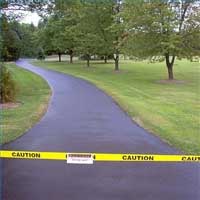Asphalt Maintenance Tampa
Asphalt Maintenance Tampa
How to Maintain Asphalt
 Asphalt driveways eventually break down from heat, sunlight, salt and wear. Keeping up with cracks before they expand, then applying an asphalt sealer prolongs the life of the driveway. A newly sealed asphalt driveway always adds a nice look to a home.
Asphalt driveways eventually break down from heat, sunlight, salt and wear. Keeping up with cracks before they expand, then applying an asphalt sealer prolongs the life of the driveway. A newly sealed asphalt driveway always adds a nice look to a home.
If you take the time to maintain your asphalt driveway, it can stay in top condition for many years. You don’t need to hire someone to do maintenance and repairs. If you have the proper materials and know the tricks of the trade, you can do it all yourself.
Clean away all gas and oil stains with detergent. Mix with water in a bucket and scrub the area with a brush.
Use crack sealer or patch to seal needed areas. Get a can or dispenser type sealer to fill in cracks under 1/2 inch and asphalt patch for larger jobs. Use a trowel to apply the patch. Read directions for drying time.
Take a garage broom and sweep away all debris. Hose the driveway clean with water.
Crack Sealants
Cracks in your asphalt driveway may occur because of wear, contraction and expansion or because of water erosion. It’s important to seal the edges of these cracks, because if they’re left open to the elements, they’ll only grow larger. Sealants will prevent further destruction of the asphalt surface.
With the high cost of replacing an existing parking lot or driveway, it is important to do regular preventive maintenance to help preserve your investment. Since your parking lot or driveway is the first thing that your customers or visitors see when they come to your business or home, a good impression is essential. Let us help you protect your asphalt investment while improving your image. If you are thinking of installing a new parking lot or residential driveway, we can do that too!
What to Do
The following are examples of some typical cases of pavements requiring maintenance, and the proper methods of correcting the deficiencies
Pavement in Good Condition
Typically, a pavement in good condition might exhibit fine cracking, and some raveling of the fine aggregate; the ordinary
effects of some wear and tear.
The remedy for this condition is the application of a seal coat. A seal coat is a thin asphalt surface treatment used to waterproof and improve the texture of an asphalt wearing surface.
Another important consideration in applying seal coat to parking lots is curing time. Since the seal coat does require many hours to cure, alternative parking should be available during the application and curing period, so that those using the facility will not be inconvenienced by the temporary tackiness of the surface.
Pavement in Fair condition
Such a pavement might be characterized by random cracks of up to .25″ in width, and raveled aggregate.
The random cracks should be filled with hot applied rubber and heat. The cracks should be prepared for filling by removing vegetation and cleaning with a stream of compressed air. The cracks are then injected with sealant. Fine cracks, up to 1/8″ wide, are too small to effectively fill, and can usually be ignored when a seal coat is to follow.
After the cracks have been filled, the parking lot should be covered with a seal coat.
Pavement in poor condition
This pavement may display random cracks, raveled aggregate, depressions, local alligatored areas, pot holes, and perhaps upheaval.
First, the areas of local distress – that is the alligatored areas, pot holes, and upheavals – should be repaired. This is accomplished by constructing a Full-Depth asphalt patch. If water is a cause of failure, install drainage if necessary. Then compact the subgrade until it is firm and unyielding.
Following the repair of local distress, the cracks should be filled if sealcoating is to follow.
Depressed areas should be restored to the proper cross-section by applying a leveling or wedge course if resurfacing. This is an asphalt layer of variable thickness, specifically intended to eliminate irregularities in the contour of an existing surface prior to an overlay.
An asphalt overlay or an seal coat should then be applied.
These suggested repair procedures are not the only effective maintenance techniques. Some parking lots will develop problems other than the more common pavement defects discussed in this publication. Additionally, alternative methods and materials are commonly used in some areas to adapt to local conditions. The preceding examples should, however, serve as a useful guide to the types of repairs generally required to maintain a parking lot, as nearly as possible, in its as-constructed condition.
